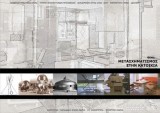In order to appreciate the importance of transformation in the ground of dwelling we must go back in different social and cultural structures. Since the first dwellings of the prehistoric nomads until gypsies and contemporary famous examples it’s obvious that transformation in an integral part of the house.
Every house has, in some degree, the ability of adjusting to the needs of the dweller, either by opening or closing a window either by adding or removing an entire wall. The difference lies on the effort and the time needed. However the purpose is the same: the best possible satisfaction of the dweller’s needs that concerns either survival or comfort.
By examining the mechanism of transformation as well as a number of examples, we are able to notify some differences that concern geometry, joints, the number of elements of which is consisted and their connection etc. In every case we observe that the transformation affects the change or motion of the borders between inside an outside or between different inner spaces.
What is the role of transformation in contemporary dwelling? Is it a need or a luxury? At most examples the abilities of transformable dwellings, either increase the level of comfort of the house dwellers by adding extra space or by changing the relation with the outer environment or by forming the indoor spacein the best possible way. The role of transformation in the dwelling is to adjust it to the needs of men increasing his quality of life that concerns the protection and exploit of the weather as well as the goodviabilityof the inner space.
